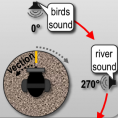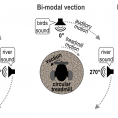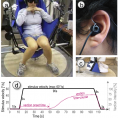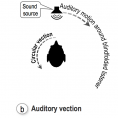How can we provide humans with a believable sensation of being in and moving through computer-generated environments (like VR, computer games, or movies) without the need for costly and cumbersome motion platforms or large free-space walking areas? That is, how can we “cheat intelligently” by providing a compelling, embodied self-motion illusion (“vection”) without the need for full physical motion?
In a series of experiments, we investigated the contribution and interaction of different sensory modalities as well as higher-level, cognitive influences.
Below is a selection of such work [more will come as the website evolves]
Spatialized Sound Enhances Biomechanically-Induced Self-Motion Illusion (Vection)
The use of vection, the illusion of self-movement, has recently been explored as a novel way to immerse observers in mediated environments through illusory yet compelling self-motion without physically moving. This provides advantages over existing systems that employ costly, cumbersome, and potentially hazardous motion platforms, which are often surprisingly inadequate to provide life-like motion experiences. This study investigates whether spatialized sound rotating around the stationary, blindfolded listener can facilitate biomechanical vection, the illusion of self-rotation induced by stepping along a rotating floor plate. For the first time, integrating simple auditory and biomechanical cues for turning in place evoked convincing circular vection. In an auditory baseline condition, participants experienced only spatialized auditory cues. In a purely biomechanical condition, seated participants stepped along sideways on a rotating plate while listening to mono masking sounds. Scores of the bi-modal condition (binaural biomechanical cues) exceeded the sum of both single cue conditions, which may imply super-additive or synergistic effects.

Stepping along a rotating circular treadmill while being blindfolded can (after a few seconds) create a compelling & embodied illusion of rotating in the opposite direction[ERROR: No URL was passed to the generic video BBCode]. Studying such “biomechnically-induced circular vection” can help us to better understand human multi-modal information processing and eventually help us to improve motion simulation in Virtual Reality.

First demo of our new circular treadmill in the iSpace lab. Since then the setup has had some major updates.
Why not build an omni-directional treadmill so people can walk in all direction in the Virtual Environment? While recent progress has been amazing, such omni-directional treadmills are still huge, loud, expensive, and need many safety measures (see video below for an example from the Cyberwalk project). In addition, it seems that walking-in-place can only reliably induce circular vection, but not translational/linear vection. Hence, we decided to focus on using out understanding if human multi-modal cue integration to “cheat intelligently” and aiming for a compelling embodied illusion of self-motion (i.e., “perceptual realism/effectiveness”) instead of aiming for biomechanical/stimulus realism.

Media Gallery
Related Publications
http://ispace.iat.sfu.ca/wp-content/plugins/zotpress/
37904
Feuereissen, D. 2008. “VR: Getting the Reality Part Straight – Does Jitter and Suspension of the Human Body Increase Auditory Circular Vection?” Bachelor’s Thesis, Department of Computer Science in Media.
http://www.kyb.mpg.de/publication.html?publ=5071.
37904
Palmisano, Stephen, Shinji Nakamura, Robert S. Allison, and Bernhard E. Riecke. 2020. “The Stereoscopic Advantage for Vection Persists Despite Reversed Disparity.”
Attention, Perception, & Psychophysics 82 (4): 2098–2118.
https://doi.org/10.3758/s13414-019–01886-2).
37904
Keshavarz, Behrang, Aaron E. Phillip-Muller, Wanja Hemmerich, Bernhard E. Riecke, and Jennifer J. Campos. 2018. “The Effect of Visual Motion Stimulus Characteristics on Vection and Visually Induced Motion Sickness.” Displays 58 (July):71–81. https://doi.org/10.1016/j.displa.2018.07.005.
37904
Palmisano, Stephen, and Bernhard E. Riecke. 2018. “The Search for Instantaneous Vection: An Oscillating Visual Prime Reduces Vection Onset Latency.” PLOS ONE 13 (5): 1–26. https://doi.org/10.1371/journal.pone.0195886.
37904
Hashemian, A. M., Kitson, A., Nquyen-Vo, T., Benko, H., Stuerzlinger, W., & Riecke, B. E. (2018). Investigating a Sparse Peripheral Display in a Head-Mounted Display for VR Locomotion. 2018 IEEE Conference on Virtual Reality and 3D User Interfaces (VR), 571–572. https://doi.org/10.1109/VR.2018.8446345
37904
Mursic, Rebecca A., Bernhard E. Riecke, Deborah Apthorp, and Stephen Palmisano. 2017. “The Shepard-Risset Glissando: Music That Moves You.” Experimental Brain Research 235 (10): 3111–27. https://doi.org/10.1007/s00221-017‑5033-1.
37904
Riecke, Bernhard E. 2016. “Using Spatialized Sound to Enhance Self-Motion Perception in Virtual Environments and Beyond: Auditory and Multi-Modal Contributions.” Canadian Acoustics 33 (3): 148–49.
37904
Keshavarz, Behrang, Bernhard E. Riecke, Lawrence J. Hettinger, and Jennifer L. Campos. 2015. “Vection and Visually Induced Motion Sickness: How Are They Related?” Frontiers in Psychology 6 (413): 1–11. https://doi.org/10.3389/fpsyg.2015.00413.
37904
Riecke, Bernhard E., Daniel Feuereissen, John J. Rieser, and Timothy P. McNamara. 2015. “More than a Cool Illusion? Functional Significance of Self-Motion Illusion (Circular Vection) for Perspective Switches.” Frontiers in Psychology 6 (1174): 1–13. https://doi.org/10.3389/fpsyg.2015.01174.
37904
Riecke, Bernhard E., Jacob Freiberg, and Timofey Y. Grechkin. 2015. “Can Walking Motions Improve Visually Induced Rotational Self-Motion Illusions in Virtual Reality?” Journal of Vision 15 (2): 1–15. https://doi.org/10.1167/15.2.3.
37904
Riecke, Bernhard E., and Jacqueline D. Jordan. 2015. “Comparing the Effectiveness of Different Displays in Enhancing Illusions of Self-Movement (Vection).” Frontiers in Psychology 6 (713). https://doi.org/10.3389/fpsyg.2015.00713.
37904
Riecke, B. E., & Schulte-Pelkum, J. (2015). An Integrative Approach to Presence and Self-Motion Perception Research. In F. Biocca, J. Freeman, W. IJsselsteijn, M. Lombard, & R. J. Schaevitz (Eds.), Immersed in Media: Telepresence Theory, Measurement and Technology (pp. 187–235). Springer. doi: 10.1007/978–3-319–10190-3_9.
37904
Lawson, B. D., & Riecke, B. E. (2014). The Perception of Body Motion. In K. S. Hale & K. M. Stanney (Eds.), Handbook of Virtual Environments: Design, Implementation, and Applications (2nd ed., pp. 163–195). CRC Press.
37904
Riecke, Bernhard E., Daniel Feuereissen, John J. Rieser, and Timothy P. McNamara. 2014. “Can Self-Motion Illusions (Circular Vection) Facilitate Spatial Updating?” Poster presented at the Spatial Cognition 2014 Conference, Bremen, Germany.
http://conference.spatial-cognition.de/SC2014/.
37904
Riecke, B. E, Jacqueline D. Jordan, Mirjana Prpa, and Daniel Feuereissen. 2014. “Underlying Perceptual Issues in Virtual Reality Systems: Does Display Type Affect Self-Motion Perception?” Talk presented at the 55th Annual Meeting of the Psychonomic Society (Psychonomics), Los Angeles, USA.
37904
Seno, Takeharu, Stephen Palmisano, Bernhard E. Riecke, and Shinji Nakamura. 2014. “Walking without Optic Flow Reduces Subsequent Vection.” Experimental Brain Research 233 (1): 275–81. https://doi.org/doi:10.1007/s00221-014‑4109-4.
37904
Riecke, Bernhard E. 2013. “Creating a Moving Experience without Moving the Observer: Perceptual Aspects & Display Factors in Immersive Virtual Reality (and Elsewhere).” Invited Talk presented at the International Toronto Stereoscopic Film Conference, Toronto, Canada.
https://youtu.be/98hq_a_nvso.
37904
Riecke, B. E., & Schulte-Pelkum, J. (2013). Perceptual and Cognitive Factors for Self-Motion Simulation in Virtual Environments: How Can Self-Motion Illusions (“Vection”) Be Utilized? In F. Steinicke, Y. Visell, J. Campos, & A. Lécuyer (Eds.), Human Walking in Virtual Environments (pp. 27–54). Springer. doi: 10.1007/978–1-4419–8432-6_2.
37904
Freiberg, Jacob, and Bernhard E. Riecke. 2013. “Its Your Turn: Enhancing Visually Induced Self Motion Illusions (‘Vection’) with Walking Motions in Virtual Reality.” Poster presented at the 54th Annual Meeting of the Psychonomic Society (Psychonomics), Toronto, Canada.
37904
Riecke, Bernhard E., Salvar Sigurdarson, and Andrew P. Milne. 2012. “Moving Through Virtual Reality Without Moving?” Cognitive Processing 13 (1): 293–97. https://doi.org/10.1007/s10339-012‑0491-7.
37904
Riecke, B. E. (2011). Compelling Self-Motion Through Virtual Environments Without Actual Self-Motion – Using Self-Motion Illusions (“Vection”) to Improve User Experience in VR. In J. Kim (Ed.). In J.-J. Kim (Ed.),
Virtual Reality (pp. 149–176). InTechOpen.
https://www.intechopen.com/books/virtual-reality/compelling-self-motion-through-virtual-environments-without-actual-self-motion-using-self-motion-ill
37904
Riecke, Bernhard E., Aleksander Väljamäe, and Jörg Schulte-Pelkum. 2009. “Moving Sounds Enhance the Visually-Induced Self-Motion Illusion (Circular Vection) in Virtual Reality.” ACM Transactions on Applied Perception (TAP) 6 (March):7:1–7:27. https://doi.org/10.1145/1498700.1498701.
37904
Riecke, Bernhard E. 2009. “Cognitive and Higher-Level Contributions to Illusory Self-Motion Perception (‘Vection’): Does the Possibility of Actual Motion Affect Vection?”
Japanese Journal of Psychonomic Science 28 (1): 135–39.
http://ci.nii.ac.jp/naid/110007482465.
37904
Riecke, B. E., D. Feuereissen, and J. J. Rieser. 2009. “Rotating Sound Fields Can Facilitate Biomechanical Self-Motion Illusion (‘circular Vection’).” Journal of Vision 9 (8): 714–714. https://doi.org/10.1167/9.8.714.
37904
Riecke, Bernhard E., Daniel Feuereissen, and John J Rieser. 2009. “Auditory Self-Motion Simulation Is Facilitated by Haptic and Vibrational Cues Suggesting the Possibility of Actual Motion.” ACM Transactions on Applied Perception (TAP) 6:20:1–20:22. https://doi.org/10.1145/1577755.1577763.
37904
“Contribution and Interaction of Auditory and Biomechanical Cues for Self-Motion Illusions (‘circular Vection’).” 2008. Poster presented at the CyberWalk workshop, Tübingen, Germany.
37904
Riecke, Bernhard E., D. W. Cunningham, and H. H. Bülthoff. 2007. “Spatial Updating in Virtual Reality: The Sufficiency of Visual Information.” Psychological Research 71 (3): 298–313. https://doi.org/10.1007/s00426-006‑0085-z.
37904
Schulte-Pelkum, J. 2007. “Perception of Self-Motion: Vection Experiments in Multi-Sensory Virtual Environments.” PhD thesis, Ruhr-Universität Bochum.
https://hss-opus.ub.ruhr-uni-bochum.de/opus4/frontdoor/deliver/index/docId/2735/file/diss.pdf.
37904
Riecke, Bernhard E., Jörg Schulte-Pelkum, Marios N Avraamides, Markus Von Der Heyde, and Heinrich H Bülthoff. 2006. “Cognitive Factors Can Influence Self-Motion Perception (Vection) in Virtual Reality.” ACM Transactions on Applied Perception (TAP) 3 (July):194–216. https://doi.org/10.1145/1166087.1166091.
37904
Riecke, B. E., & Schulte-Pelkum, J. (2006).
Using the perceptually oriented approach to optimize spatial presence & ego-motion simulation (No. 153). MPI for Biological Cybernetics.
http://www.kyb.mpg.de/publication.html?publ=4186
37904
Riecke, B. E., J. Schulte-Pelkum, and F. Caniard. 2006. “Visually Induced Linear Vection Is Enhanced by Small Physical Accelerations.” Poster presented at the 7th International Multisensory Research Forum (IMRF), Dublin, Ireland.
37904
Riecke, B. E., J. Schulte-Pelkum, F. Caniard, and Heinrich H. Bülthoff. 2005. “Auditory Cues Can Facilitate the Visually-Induced Self-Motion Illusion (Circular Vection) in Virtual Reality.” Poster presented at the 8. Tübingen Perception Conference (TWK), Max Planck Institute for Biological Cybernetics, Germany.
37904
Riecke, B. E., Schulte-Pelkum, J., Caniard, F., & Bülthoff, H. H. (2005).
Spatialized auditory cues enhance the visually-induced self-motion illusion (circular vection) in Virtual Reality. (No. 138). MPI for Biological Cybernetics.
http://www.kyb.mpg.de/publication.html?publ=4187
37904
Schulte-Pelkum, J., Bernhard E. Riecke, Franck Caniard, and Heinrich H. Bülthoff. 2005. “Can Auditory Cues Influence the Visually Induced Self-Motion Illusion?” Poster presented at the European Conference on Visual Perception (ECVP).
37904
Riecke, B. E., J. Schulte-Pelkum, M. N Avraamides, M. von der Heyde, and Heinrich H Bülthoff. 2004. “Top-down Influence on Visually Induced Self-Motion Perception (Vection).” Poster presented at the 7. Tübingen Perception Conference (TWK), Tübingen, Germany.
37904
Riecke, B. E., J. Schulte-Pelkum, M. N. Avraamides, M. von der Heyde, and H. H. Bülthoff. 2004. “The Effect of Cognition on the Visually Induced Illusion of Self-Motion (Vection).” Journal of Vision 4 (8): 891a. https://doi.org/10.1167/4.8.891.
37904
Schulte-Pelkum, J., B. E. Riecke, and H. H Bülthoff. 2004. “Vibrational Cues Enhance Believability of Ego-Motion Simulation.” Poster presented at the International Multisensory Research Forum (IMRF), Barcelona, Spain.
37904
Schulte-Pelkum, J., B. E. Riecke, M. von der Heyde, and H. H. Bülthoff. 2003. “Screen Curvature Does Influence the Perception of Visually Simulated Ego-Rotations.” Journal of Vision, Poster presented at VSS, 3 (9). https://doi.org/doi: 10.1167/3.9.411.
37904
Schulte-Pelkum, J., B. E. Riecke, M. von der Heyde, and H. H. Bülthoff. 2003. “Circular Vection Is Facilitated by a Consistent Photorealistic Scene.” Talk presented at the Presence 2003 Conference, Aalborg, Denmark.








